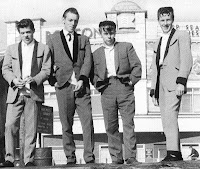Playing with styles, mixing and
combining different clothes and accessories from different eras and cultures,
has been a hugely successful trend since the seventeenth century.
 |
| Bloomers |
The fun of variety runs through the world of fashion, and you can often express your personality
best with a mix of different styles.The taste for mix and
match started at the end of the seventeenth century when exotic Chinese silks
printed with birds, leaves and flowers were imported in Europe. Bringing together the flamboyance of
the Baroque and fabrics with Eastern cuts, the fashion of the time created a
cultural fusion between the two worlds. With the French Revolution, exoticism
lost its hold – but it returned into fashion with Elizabeth
Smith Miller and her “bloomer” movement. In her magazine The Lily, she promoted a new way of dressing, pairing knee-length dresses and belts with wide Oriental trousers and boots.
 |
| Teddy Boys |
The style was criticized by contemporaries, and Amelia Jenks Bloomer – one of its main exponents – abandoned
it in 1853. The idea of combining different cultures was taken up some decades
later by Paul Poiret. Influenced by Diaghilev’s ballet, he brought together the Japanese kimono and the shapes of the Greek tunic and the kaftan,
combining strong colours like orange, plum and black with the pastel shades of
the Belle Époque. Later, in the 20s,Coco Chanel created the idea of “simple luxury” and by mixing basic pieces like
cardigans, white sweaters and skirts above the knee, defended a straightforward
take on luxury. Thanks to collaborations between artists like Jean Cocteau and
Dalí with designers like Elsa Schiaparelli, Surrealism created a way of dressing
freely, and in a way that was ironic and fun. After World War II, the Teddy Boys in Britain reinterpreted the American look, rock
‘n’ roll and the Edwardian era. They mixed jackets, velvet shirts, skinny pants,
narrow ties and Slim Jim shoes, expressing their opposition to the values of
the 50s. In the 70s, punk appeared as an anti-conformist movement that ran
against the reigning ideology of the time.
It paired necklaces with ripped
clothes, completing the look with shaved heads, Mohicans and piercings. Its main driving-forces were Malcolm McLaren and Vivienne Westwood, who opened a punk shop in London’s
King’s Road. During the 80s, cultural diversity and contact with African and
Asian cultures party influenced ways of dressing. According to
the work of the sociologist Gilles Lipovetsky, the continual need for reinvention
has created sub-cultures in our hyper-modern age which use mix and match to
bring individuals together in shared ideologies or lifestyles. One current designer who combines
contrasting elements is John Galliano. As German designer Lutz, who is fascinated
by blending different styles, said in Fashion Now
2: “I take things that
are basic, integral parts of everyday life, and mix them all together so in turn they stay familiar but at the same time become something completely different.”



0 comments:
Post a Comment